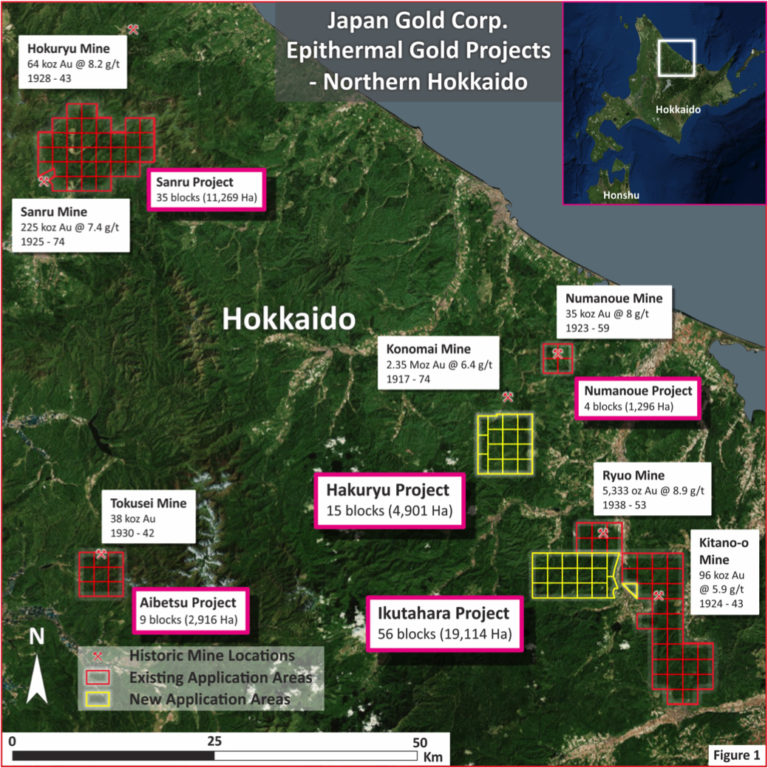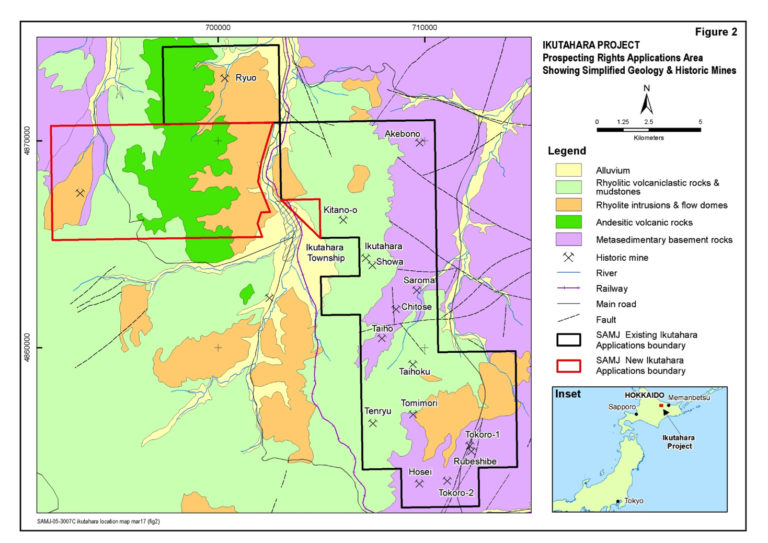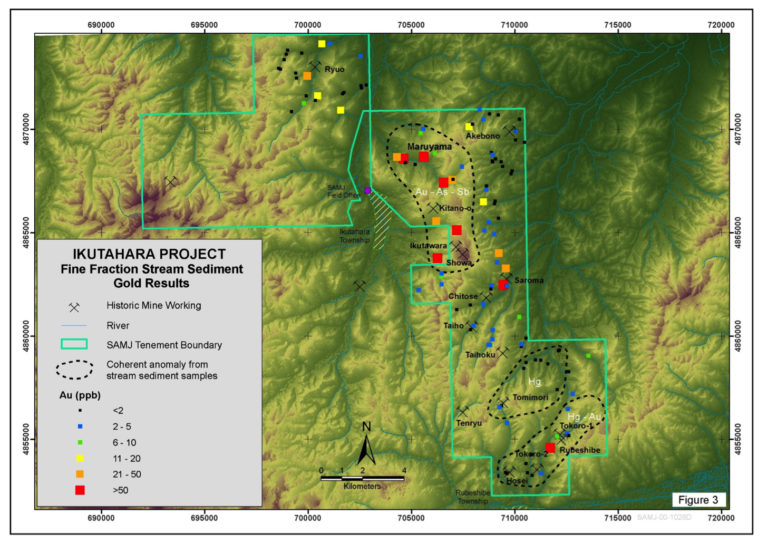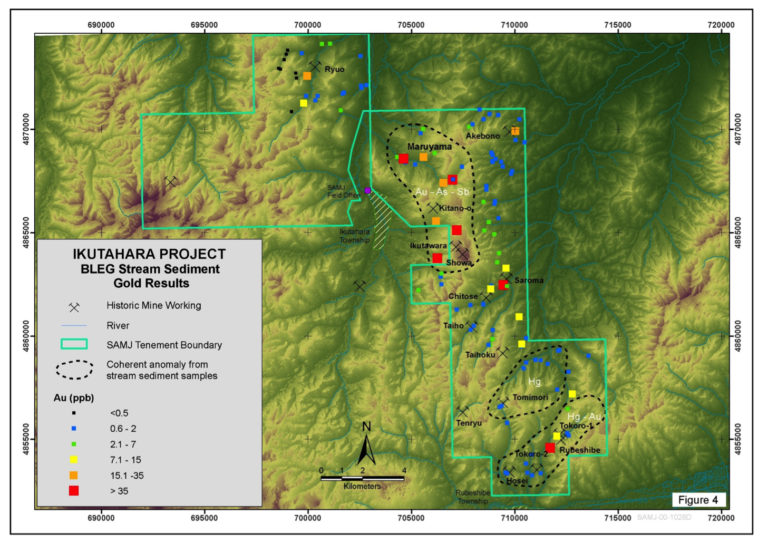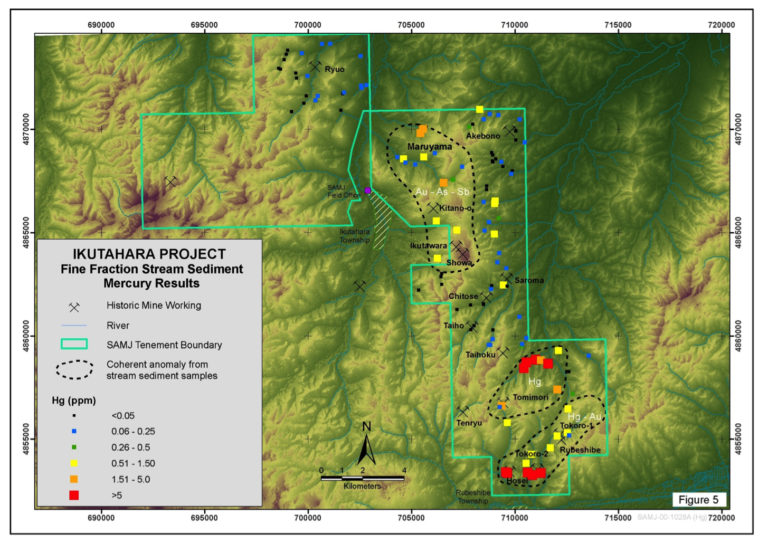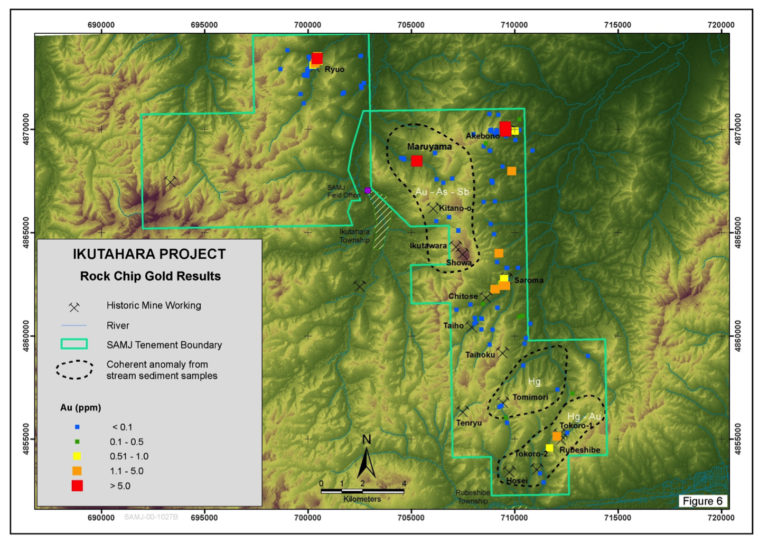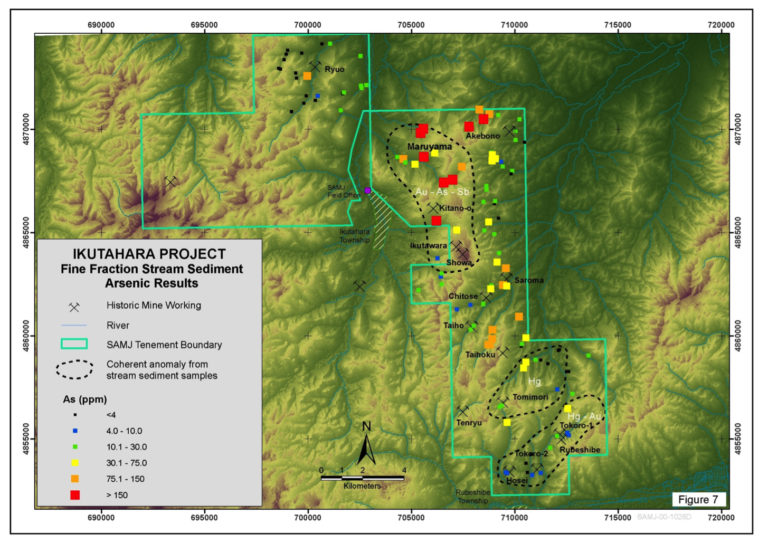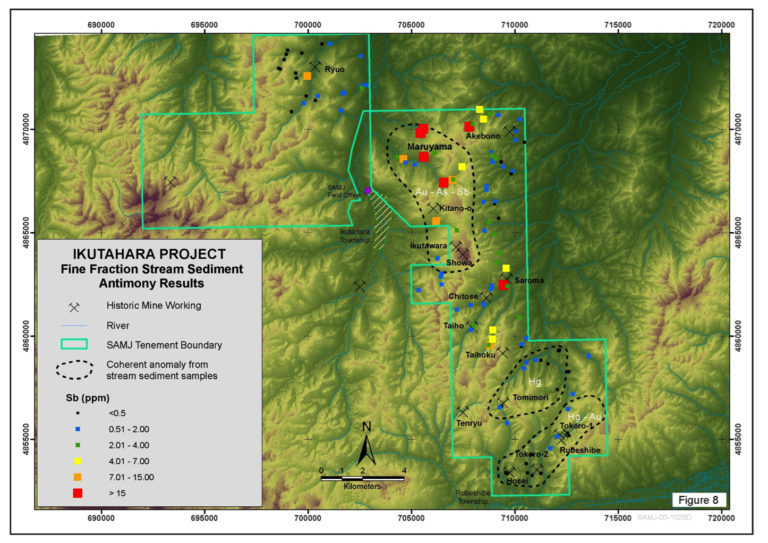NEWS RELEASE
March 03, 2017– Vancouver, BC – Japan Gold Corp. (TSX-V: JG) (“Japan Gold” or the “Company”) is pleased to announce that it has expanded its project portfolio in Japan and compiled the results of the 2016 regional exploration program at the Ikutahara Project in north Hokkaido, Japan, to further define targets for the 2017 exploration program.
Project Portfolio Expansion
The Ministry of Economy, Trade and Industry (METI) has accepted two new areas of prospecting applications. Of the two new application areas, one area immediately adjoins the Ikutahara Project and a second, the Hakuryu Project, is located immediately south of Japan’s third largest gold mine, Konamai, which operated between 1917-1974 and produced over 2.3 Moz of gold at an average grade of 6.4 g/t 1 (Figure 1). The two new application areas comprise 5,828 and 4,901 hectares respectively. Both application areas have been received by METI and Japan Gold now holds priority over these areas.
The new Hakuryu Project is underlain by the same host geology as the Konamai mine which consists of the Konamai Formation sedimentary rocks which are cut by Late Miocene andesite and rhyolite subvolcanic intrusions. Eight historic gold workings are located within the applications based on the published government geological maps.
The new applications at the Ikutahara Project are located immediately south of the high-grade Ryuo prospect and west of the Kitano-o mine area. One historic gold occurrence is located within the new applications and the area is underlain by the same Miocene-Pliocene geology as the rest of the Ikutahara Project. These same geological structures host the high-grade Ryuo prospect and continue into this new block. Geological structures that host the high-grade Ryuo prospect continue southwest into this new block.
The Company now has 148 prospecting rights license applications accepted in northern Japan for a combined area of 49,150 hectares over ten separate projects. Nine of these applications have been granted as Prospecting Rights.
2016 Regional Exploration Program
The Company is pleased to announce encouraging results from the 2016 regional exploration program at the Ikutahara Project.
Six geologists and support teams undertook a nine-week field program from October to December 2016, completing prospecting, geological mapping, collecting stream sediment BLEG and fine fraction drainage samples and rock float and outcrop sampling over the majority of the Ikutahara Project (not including the new Ikutahara Project applications). Located 20 km southeast of the historic Konamai mine, the Ikutahara Project (including the new Ikutahara Project applications) hosts sixteen historic gold mines and workings. This includes the Kitano-o mine (1924-43) which is reported to have produced 96,450 ounces of gold from mining of gold-bearing eluvium associated with sinter deposits and sub-sinter epithermal veins (Figure 2).
John Proust, Japan Gold Chairman & CEO commented “We are pleased to expand our ground holdings to a more dominant position in these highly prospective geological locations of Japan. We are also very encouraged by the results of our 2016 regional exploration program that highlights large coherent gold and gold-pathfinder anomalies over extensive drainage areas at the Ikutahara Project. These results allow us to better focus ongoing detailed surface exploration work in this highly mineralized but under-explored belt of historic gold mines. We plan to do further detailed prospect mapping and surface geochemical surveys over priority targets, in conjunction with drilling testing on the high-grade Ryuo and Akebono veins in 2017.”
Results of Regional Stream Sampling Program
The first-pass regional stream sampling program at the Ikutahara Project involved the collection of 118 BLEG samples for gold analysis paired with 118 fine fraction (FF) samples for gold and multielement analysis3. Extensive gold, arsenic, antimony and mercury anomalies are recorded throughout the project and contrast the differing levels of erosion of the epithermal vein systems throughout the project.
The largest coherent gold anomaly is defined by seven (7) BLEG and fine fraction samples collected on the central western side of the project area (Figures 3 and Figure 4). This anomaly is supported by elevated arsenic, antimony and mercury results and covers an area of approximately 5-km by 2-km over a N-S alignment of conical hills and ridgelines that host the historic Kitano-o, Ikutahara & Showa gold workings and Maruyama gold prospect, (Figure 5, Figure 6, Figure 7, Figure 8). The anomalous gold, arsenic, antimony and mercury results range from 25.9 to 499 ppb Au (BLEG), 22 to 731 ppb Au (FF), 139 to 343 ppm As, 7 to 57.8 ppm Sb, and 0.58 to 1.84 ppm Hg, respectively.
The extent of this combined gold-arsenic-antimony-mercury anomaly represents a large, shallowly-eroded area of hydrothermally altered and mineralized rhyolitic volcanic and associated sedimentary rocks. Although this area contains one of the most significant historic gold mines in the district, it has had little modern exploration. Mineralisation at Kitano-o, Ikutahara and Showa gold workings is unique as miners exploited surficial gold mineralization associated with silica-sinter deposits and sub-sinter veins. Such deposits represent the paleo-surface expression of epithermal vein deposits developing at depth. As the sinter is mineralized it is apparent that the area has undergone multiple overprinting hydrothermal events, which is supported by K-Ar age dating of various separate mineralization events between 7.7-7.4 Ma, 4.2 Ma and 2.6 Ma2 , further adding to the compelling nature of this target.
Sample responses from the Ryuo mine and Akebono gold-silver workings, which have produced some spectacular high-grade results from historic underground sampling (see JG:TSX Announcement of 9 February 2017), are more subdued with maximum results of 17.3 ppb Au (BLEG) and 25 ppb Au (FF) at Ryuo and 17.3 ppb Au (BLEG) and 3 ppb Au (FF) at Akebono. A small drainage basin located to the west of Akebono returned one anomalous gold result of 15 ppb Au (FF) within a cluster of moderate to strong arsenic and antimony results ranging from 82.5 to 326 ppm As and 3.8 to 17.1 ppm Sb, respectively. These coincident gold, arsenic and antimony results may be significant by indicating the potential for additional high-grade gold-silver veins at depth and will also be followed up as a priority in the 2017 field season.
Two distinctive clusters of moderate to strong mercury results are highlighted from fine fraction samples taken at the southern end of the project area, which contains historic mercury workings with some associated gold occurrences including Tokoro-2 (Hg), Hosei (Hg) and Tomimori (Hg), Tokoro-1 (Au), Rubeshibe (Au) and Taihoku (Au). The two mercury anomalies, each defined by at least five samples, cover several square-kilometers of drainage area and returned results ranging from 4.67 to 28.3 ppm Hg and 5.16 to 660 ppm Hg, respectively. Highly anomalous gold results of up to 74.1 ppb (BLEG) and 274 ppb Au (FF) were returned on the eastern edge of the second mercury anomaly and are associated with the Tokoro and Rubeshibe gold workings. The mercury and gold workings in this area are controlled by the same regional fault structures. Mercury concentrations often occur above gold zones in epithermal systems. The presence of these large mercury anomalies indicates the vein systems are probably exposed at a very high level and therefore largely intact, underscoring the potential in this area.
Results of Regional Rock Sampling Program
Results from rock sampling done concurrently with the drainage survey support the gold, arsenic, antimony and mercury anomalies returned from stream sediments. A total of 294 surface rock samples were collected for gold and multielement analysis4. These samples are of a reconnaissance nature and are selected grab chips taken from creek float, mine dumps and occasional outcrops of vein material, silica sinter, hydrothermal breccia and altered host rock, (Figure 6). Following is a summary of selected rock sampling results from this initial survey.
- Gold– 23 samples returned >1 g/t Au with maximum results of 43.8 g/t Au & 20.7 g/t Au; another 62 samples returned anomalous gold in the range 0.1 to 0.93 g/t Au.
The max. 43.8 g/t Au result with elevated silver (27.2 g/t Ag), arsenic (282 ppm As), antimony (19 ppm Sb) & molybdenum (6 ppm Mo) is from an outcrop of strongly silicified and sulphidic, brecciated grey-black siltstone/lithic sandstone exposed in Maruyama Creek within an area of strong gold anomalism in colluvium and bedrock that was previously identified by the Austpac/Nishio Iwai JV in the late 1980’s.
A 15-cm float cobble of lattice bladed microcrystalline quartz-adularia vein shedding from colluvium about 150-m downslope from the Akebono gold working returned 20.7 g/t gold and 290 g/t silver with elevated arsenic (74 ppm As), antimony (65.8 ppm Sb) & mercury (0.21 ppm Hg).
- Arsenic– 127 samples returned >100 ppm As to maximum 5,980 ppm As.
The max. 5,980 ppm As result with elevated antimony (230 ppm Sb), gold (0.46 g/t Au) and silver (1.3 g/t Ag) is from a 30-cm float cobble of highly silicified black siltstone cut by thin quartz veins and containing strongly disseminated bladed marcasite-arsenopyrite mineralization; associated with a cluster of low gold and moderate As-Sb stream sediment anomalies located in creeks NW of the historic Akebono workings.
- Antimony– 88 samples returned >25 ppm Sb to maximum 407 ppm Sb.
The max. 407 ppm Sb result with elevated arsenic (387 ppm As) and mercury (1.4 ppm Hg) is from an outcrop of highly sulphidic & silicified hydrothermal breccia located above and along strike from the Ryuo gold-silver workings; the breccia contains low gold (0.5 ppm Hg to maximum 120 ppm Hg.
- Mercury– 77 samples returned >0.5 ppm Hg to maximum 120 ppm Hg.
The max. 120 ppm Hg result is from a 30-cm float cobble of microcrystalline quartz-carbonate-sulphide veined black siltstone/lithic sandstone with a corresponding 660 ppm Hg result from a stream sediment sample taken in the same creek shedding from the historic Tokoro mercury mine and associated with a strong cluster of Hg stream sediment anomalies at the southern end of the project area.
Ikutahara Project Overview
The Ikutahara Project now comprises 56 Prospecting Rights Application blocks covering an area of 19,114 ha underlain by prospective Miocene-Pliocene age volcano-sedimentary rocks and older meta-sedimentary basement rocks.
Multiple gold-silver and mercury prospects including sixteen documented mines and workings are located within the expanded project area and the majority comprise epithermal veins, with other hot spring related features such as hydrothermal breccias and silica sinters.
The prospects were discovered and intermittently mined between 1910 and 1943. Gold mining in Japan was suspended 1943 under a government regulation aimed at focusing resources to more strategic commodities during World War II. Many of the historic workings that were active in the area stopped in ore and never reopened. The project area has seen only minor exploration since that time.
The most significant historic gold production in Japan Gold’s Ikutahara project came from the Kitano-o mine (1924-43), reported to have produced 96,4502 ounces of gold from mining of gold-bearing eluvium associated with sinter deposits and sub-sinter epithermal veins within rhyolitic volcanic rocks. Within the central part of the project area the Kitano-o, Showa and Ikutahara mines represent a unique style of ‘high-level’ gold mineralization. Sinter deposits generally represent the surface expression or outflow of epithermal vein systems developing at depth. The Company will be exploring for such vein zones that may lay at depth beneath these high-level deposits; and depth and strike extensions of the numerous other vein targets.
Reference
1 Watanabe, 1996. Genesis of Vein-hosting Fractures in the Kitami Region, Hokkaido, Japan. Resource Geology, v46(3), pp 151-166, 1996.
2 Maeda, 1997. K-Ar Age of Mercury Mineralisation and Related Volcanic Activity in the Kitami Metallogenic Province, Hokkaido, Japan. Resource Geology, v47, pp11-20, 1997.
3See explanation of sample collection and assaying at the end of announcement.
4 See explanation of sample collection and assaying at the end of announcement.
On behalf of the Board of Japan Gold Corp.
“John Proust”
Chairman & CEO
About Japan Gold Corp.
Japan Gold Corp. is a Canadian mineral exploration company focused solely on gold and copper-gold exploration in Japan. The Company has applied for 148 prospecting rights licenses in northern Japan for a combined area of 49,150 hectares over ten separate projects. Nine of the applications have been granted as Prospecting Rights.
The applications cover areas with known gold occurrences and a history of mining, and are prospective for both high-grade epithermal gold mineralization and gold-bearing lithocaps, which could indicate the presence of porphyry mineralization. Japan Gold’s leadership team has decades of resource industry and business experience, and the Company has recruited geologists and technical advisors with experience exploring and operating in Japan. More information is available at www.japangold.com or by email at
Japan Gold Contacts
John Proust
Chairman & CEO
Phone: +1 778 725-1491
Email:
Cautionary Note
Neither the TSX Venture Exchange nor its Regulation Services Provider (as such term is defined in the policies of the TSX Venture Exchange) accepts responsibility for the adequacy or accuracy of this release.
This news release contains forward-looking statements relating to expected or anticipated future events and anticipated results that are forward-looking in nature and, as a result, are subject to certain risks and uncertainties, such as general economic, market and business conditions, competition for qualified staff, the regulatory process and actions, technical issues, new legislation, uncertainties resulting from potential delays or changes in plans, uncertainties resulting from working in a new political jurisdiction, uncertainties regarding the results of exploration, uncertainties regarding the timing and granting of prospecting rights, uncertainties regarding the Company’s ability to execute and implement future plans, and the occurrence of unexpected events. Actual results achieved may vary from the information provided herein as a result of numerous known and unknown risks and uncertainties and other factors.
The technical information in this news release has been reviewed by Japan Gold’s President & Chief Operating Officer, Dr. Mike Andrews, PhD, FAusIMM, who is a Qualified Person as defined by National Instrument 43-101.
Stream Sediment Sampling and Analysis
Two samples each weighing about 2-3 kg were collected from the last deposited stream sediment of the active creek channel at each sample site. The first sample was sieved to collect a minus 1.2 mm (16 mesh) fraction sediment sample and the second sample was sieved to collect a minus 0.84 mm (20 mesh) fraction sediment sample. The samples were packaged to prevent any contamination and dispatched under a secure chain-of-custody in two separate batches to ALS Minerals in Perth, Australia for additional sample preparation and geochemical analysis.
The -1.2 mm fraction samples were weighed as received and then analyzed for gold-only by the Bulk Leach Extractible Gold (‘BLEG’) technique by 12-hour bottle roll leach using dilute alkaline sodium cyanide solution and then gold determination by ICPMS.
The -0.84 mm fraction samples were dried and further screened to obtain sufficient -180 micron (80 mesh) material for gold analysis by 25g-charge aqua regia digestion/AAS finish and 49 multielement analysis (including arsenic, antimony & mercury) off the same digestion with determination by ICPMS/AES.
Duplicate samples were collected from three sites to check the repeatability of results; the repeatability of results was good. The laboratory inserts blanks, standards & sub-split pulp duplicates for Quality Control and reports these results accordingly; these results fall within acceptable levels of accuracy and precision.
Rock Sampling and Analysis
Rock samples weighing about 2-3 kg were collected and a reference chip sample of each stored in plastic chip trays. The samples were packaged and dispatched under a secure chain-of-custody in two separate batches to ALS Minerals in Guangzhou, China for preparation and geochemical analysis.
The samples were crushed and then a 1-kg split from each was fine pulverized to a nominal 85% passing 75 microns. Gold was assayed by 50g-charge fire assay/AAS finish and 49 multielement analysis (including silver, arsenic, antimony & mercury) by 4-mixed acid digestion and determination by ICPMS/AES.
The laboratory inserts blanks, standards & sub-split pulp duplicates for Quality Control and reports these results accordingly; these results fall within acceptable levels of accuracy and precision.
